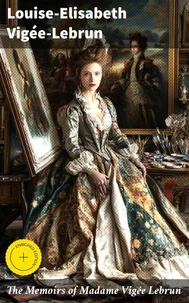The Memoirs of Madame Vigée Lebrun
Par : ,Formats :
Disponible dans votre compte client Decitre ou Furet du Nord dès validation de votre commande. Le format ePub est :
- Compatible avec une lecture sur My Vivlio (smartphone, tablette, ordinateur)
- Compatible avec une lecture sur liseuses Vivlio
- Pour les liseuses autres que Vivlio, vous devez utiliser le logiciel Adobe Digital Edition. Non compatible avec la lecture sur les liseuses Kindle, Remarkable et Sony
 , qui est-ce ?
, qui est-ce ?Notre partenaire de plateforme de lecture numérique où vous retrouverez l'ensemble de vos ebooks gratuitement
Pour en savoir plus sur nos ebooks, consultez notre aide en ligne ici
- Nombre de pages181
- FormatePub
- ISBN859-65--4702559-7
- EAN8596547025597
- Date de parution28/05/2022
- Protection num.Digital Watermarking
- Taille2 Mo
- Infos supplémentairesepub
- ÉditeurDIGICAT
Résumé
The Memoirs of Madame Vigée Lebrun is a fascinating exploration of the life and artistry of one of the 18th century's most celebrated portrait painters. Written with a vivid and engaging narrative style, Vigée-Lebrun interweaves her experiences in the male-dominated world of art with astute observations on society, gender, and patronage. The memoir offers a richly detailed account of her interactions with notable figures of the time, including Marie Antoinette, showcasing not only her artistic contributions but also the intricate social dynamics of pre-Revolutionary France.
The work serves as a significant historical document, revealing the challenges and triumphs faced by women artists in an era that often sidelined their contributions. Louise-Elisabeth Vigée-Lebrun was born into a family of painters in 1755, acquiring technical expertise from her father and a profound appreciation for the arts. Her close relationship with Queen Marie Antoinette facilitated her rise, providing her unparalleled access to the elite circles of French society.
This unique background significantly influenced her perspective, resulting in a memoir that is at once personal and broadly social, reflecting the tumultuous artistic landscape of her time. This memoir is highly recommended for readers interested in the intersections of gender, art, and history. It provides a compelling lens through which to understand not only Vigée-Lebrun's personal achievements but also the wider societal changes occurring during her lifetime.
Ultimately, it is a testament to the resilience of women in the arts, inviting readers to appreciate the richness of the past through Vigée-Lebrun's insightful recollections.
The work serves as a significant historical document, revealing the challenges and triumphs faced by women artists in an era that often sidelined their contributions. Louise-Elisabeth Vigée-Lebrun was born into a family of painters in 1755, acquiring technical expertise from her father and a profound appreciation for the arts. Her close relationship with Queen Marie Antoinette facilitated her rise, providing her unparalleled access to the elite circles of French society.
This unique background significantly influenced her perspective, resulting in a memoir that is at once personal and broadly social, reflecting the tumultuous artistic landscape of her time. This memoir is highly recommended for readers interested in the intersections of gender, art, and history. It provides a compelling lens through which to understand not only Vigée-Lebrun's personal achievements but also the wider societal changes occurring during her lifetime.
Ultimately, it is a testament to the resilience of women in the arts, inviting readers to appreciate the richness of the past through Vigée-Lebrun's insightful recollections.
The Memoirs of Madame Vigée Lebrun is a fascinating exploration of the life and artistry of one of the 18th century's most celebrated portrait painters. Written with a vivid and engaging narrative style, Vigée-Lebrun interweaves her experiences in the male-dominated world of art with astute observations on society, gender, and patronage. The memoir offers a richly detailed account of her interactions with notable figures of the time, including Marie Antoinette, showcasing not only her artistic contributions but also the intricate social dynamics of pre-Revolutionary France.
The work serves as a significant historical document, revealing the challenges and triumphs faced by women artists in an era that often sidelined their contributions. Louise-Elisabeth Vigée-Lebrun was born into a family of painters in 1755, acquiring technical expertise from her father and a profound appreciation for the arts. Her close relationship with Queen Marie Antoinette facilitated her rise, providing her unparalleled access to the elite circles of French society.
This unique background significantly influenced her perspective, resulting in a memoir that is at once personal and broadly social, reflecting the tumultuous artistic landscape of her time. This memoir is highly recommended for readers interested in the intersections of gender, art, and history. It provides a compelling lens through which to understand not only Vigée-Lebrun's personal achievements but also the wider societal changes occurring during her lifetime.
Ultimately, it is a testament to the resilience of women in the arts, inviting readers to appreciate the richness of the past through Vigée-Lebrun's insightful recollections.
The work serves as a significant historical document, revealing the challenges and triumphs faced by women artists in an era that often sidelined their contributions. Louise-Elisabeth Vigée-Lebrun was born into a family of painters in 1755, acquiring technical expertise from her father and a profound appreciation for the arts. Her close relationship with Queen Marie Antoinette facilitated her rise, providing her unparalleled access to the elite circles of French society.
This unique background significantly influenced her perspective, resulting in a memoir that is at once personal and broadly social, reflecting the tumultuous artistic landscape of her time. This memoir is highly recommended for readers interested in the intersections of gender, art, and history. It provides a compelling lens through which to understand not only Vigée-Lebrun's personal achievements but also the wider societal changes occurring during her lifetime.
Ultimately, it is a testament to the resilience of women in the arts, inviting readers to appreciate the richness of the past through Vigée-Lebrun's insightful recollections.


